NOT TRANSLATABLE: On the Flathead reservation, recording the Kootenai worldview in its own words
Story by Kevin Dupzyk
Photos by Kate Siberell
IT’S A SPRING Monday in Elmo, and a small gathering of people are ready to hear Adeline Mathias tell a story.
Mathias’ voice speaks, a slight static fuzz behind her Kootenai words. Then linguist Dorothy Berney clicks pause with the computer mouse. Silence.
Catherine Andrew translates the digital recording of Mathias’ voice: “It isn’t going to be a fairy tale; it’s going to be a true story.”
Berney types the translation into her chunky black laptop.
Catherine and her sister Louise Andrew help Berney transcribe Mathias’ storytelling. It’s slow, painstaking work, but the elderly sisters enjoy it. No one speaks Kootenai like Mathias anymore.
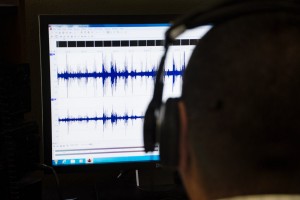 The meeting place is a small trailer between Elmo’s large green community hall and a retirement home. Inside is a mix of workspace and the comforts of home: two offices, a conference table, a whiteboard, a small kitchen, a couch and armchairs, a big-screen TV. Most everyone is settled into the couch and armchairs.
The meeting place is a small trailer between Elmo’s large green community hall and a retirement home. Inside is a mix of workspace and the comforts of home: two offices, a conference table, a whiteboard, a small kitchen, a couch and armchairs, a big-screen TV. Most everyone is settled into the couch and armchairs.
Mathias’ great-grandson, Daniel Stiffarm, sits at a computer nearby, headphones on, jagged lines of sound waves unfurling across the monitor in front of him.
Another few words from Mathias. Catherine and Louise talk; Berney types. The story is about a hunting party. This goes on for four hours. By the end of the day’s session, a few minutes of storytelling have been transcribed.
The Andrew sisters are two of the few remaining speakers for whom Kootenai is their first language. Younger generations only hear the language on occasion and speak with degraded pronunciation and little nuance. So the sisters and another woman, Alice Hewankorn, meet regularly with Berney to translate and transcribe old recordings of people like Mathias, who spoke Kootenai as her primary language.
Preserving speakers means new learners will be able to hear Kootenai as it has always been spoken, even when the people who have always spoken it are gone. Otherwise, Kootenai may survive — but it may not truly be Kootenai.
THIS PARTICULAR Monday is St. Patrick’s Day, and Catherine and Berney discuss how to say “Ireland” in Kootenai. As an approximation for “Emerald Isle,” they coin a Kootenai word for “Green Island.” But the word for “something that is green” can also mean “watermelon.” A direct translation back to English might lose something, but in Kootenai, it makes sense.
Catherine and Louise squabble over who is older, and by how much. Catherine is the younger of the two. She walks taller and has fewer lines on her face.
Many of the recordings are of Louise and Catherine’s mother, Mary Andrew. As a little girl, Louise saw her tell her stories. She would sit on the bed in her mother’s room, watching her beading and talking into a recorder.
“When I first heard her tape, it tore me up inside,” Catherine says. “Two, three times I heard her voice, and it’s just like she’s right here sitting with me.”
The sisters have an arrangement with Berney, who is not a tribal member but has been employed by the Kootenai Culture Committee for nearly two decades. The linguist sits in one armchair, with her laptop. Catherine sits in the other, Louise on the couch opposite, computer speakers in between.
When Berney plays a short clip of Kootenai from her laptop, the Andrew sisters repeat it back so she can transcribe it in Kootenai. Then they determine the best English rendering. The goal is to produce an accurate transcription in both languages.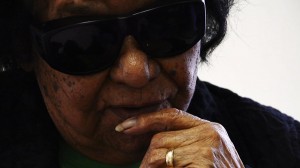
In the 1970s, the culture committee simply tried to record the elders’ memories. Now the recordings are the best record of the language on the Flathead Indian Reservation.
In Mathias’ story, the hunting party is just a few miles outside Elmo, near Sullivan Hill, known in Kootenai as “monster’s backbone.” The monster is dead; Louise says you used to be able to see its blood on the hillside.
“You can’t see it anymore. It’s faded.”
Catherine explains that the monster lived in Flathead Lake, which used to be called Monster Lake. She tries to remember the exact details of its demise.
“What was it, a bird?” she asks her sister. “A bird or something got jealous. His wife would pick huckleberries and come down here and feed that monster. He caught on, so he went and he killed that monster. I think it’s a whale, a great big thing.”
In the story, Catherine tells of how the monster left the lake to die, and its carcass is what is now called Sullivan Hill. “Suyapi, white people, call it ‘Sullivan,’” she said.
Night falls on the characters in Mathias’ story. A snow starts. After each short clip, the sisters talk Kootenai back and forth, laughing at the things Mathias says.
Berney explains that Kootenai words are often formed by combining distinct units, which can result in strange translations. “The literal pieces means, ‘That snow was ugly looking.’”
In other words, the snowstorm grew fierce.
The sisters tap their hands or feet while listening. Kootenai is rhythmic, musical even. The hard percussive sounds of consonants combine with slurred l’s and lengthy vowels to create polyrhythms that last for words, sentences, whole stories.
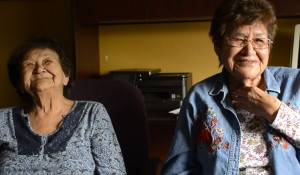 As with any language, each speaker sounds unique, conjuring different moods with the stretch of their words and the severity of their glottal stops. For 80-year-old ears that don’t hear the language as often as they’d like, it can be hard to understand. The Andrews sometimes ask Berney to replay clips. Sometimes they need her to help them recall the right words.
As with any language, each speaker sounds unique, conjuring different moods with the stretch of their words and the severity of their glottal stops. For 80-year-old ears that don’t hear the language as often as they’d like, it can be hard to understand. The Andrews sometimes ask Berney to replay clips. Sometimes they need her to help them recall the right words.
The irony that a non-tribal member plays such a crucial role in the language efforts is not lost on Catherine.
“Took a white woman to straighten it out,” she said after a particularly difficult passage.
LANGUAGE LOSS is not unique to Kootenai. The U.S. Census Bureau reported in 2011 that the 169 Native North American languages it tracks have only about 375,000 total speakers; the 10 most prominent languages account for about three-quarters of them. The Ethnologue, a language reference affiliated with the United Nations Educational, Scientific and Cultural Organization, classifies 140 languages in the US as “dying.” Most of these belong to Native American tribes.
Vernon Finley, who occupies the office next to Berney, is working on language efforts of a different sort. In May 2013, a bill introduced by State Sen. Jonathan Windy Boy passed, initiating the Montana Indian Language Preservation Pilot Program. Each tribal government in the state was awarded money to take on language projects. Working for the Kootenai Culture Committee, Finley wrote the Kootenai proposals and now leads the work. He will produce 45 beginning-level Kootenai lessons and conduct a fluency survey to assess the state of the language on the reservation.
Unique to Elmo, the language lessons have an opportunity to feed into the transcription work. Highly fluent speakers like the Andrew sisters can’t work with learners who have no foundation, and without good lessons, the foundation is shoddy. The goal of Finley’s work is to accurately teach learners enough of the language that they can continue their learning by speaking with highly fluent elders.
But what does the language look like in between “beginner” and “elder?”
PARKED ON the monster’s backbone, Daniel Stiffarm can point out some of the oxidized, rust-red dirt that was its blood. The whole hillside used to be red, but now it has faded, blown away, or grown over with scrub.
To most people, the Kootenai language is not unlike the monster. You can hear the language spoken — plant your feet firmly on its tangible existence — but the lifeblood is long gone.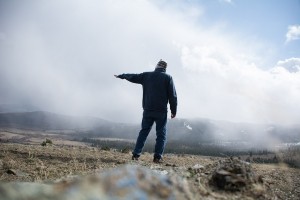
For Stiffarm, the language animates the hills, the rivers, the valleys.
His job is digitizing and cleaning up the audio recordings. He also represents perhaps the best-case scenario for speakers moving forward. He reveres and studies the language, and has benefitted from regularly hearing it as he goes through the recordings.
One of Stiffarm’s hobbies is using the stories to locate places with traditional Kootenai names. On his maps, the names cluster around Elmo and the Big Draw, a mountain valley west of Elmo. Kootenais’ historical territory was massive, but now there are just a few bands in British Columbia, one in Bonner’s Ferry, Idaho and one on the Flathead. Names move outward from Elmo in a generally northwestern direction but quickly become sparse, illustrating a major challenge that the Kootenais face: isolation.
The Flathead reservation is home to almost 30,000 people, but only a few hundred are Kootenai. Asked how many truly fluent speakers there are on the Flathead, Finley and the Andrews arrive at the same answer: “A handful.”
The language is what linguists call a “language isolate”: It’s not known to be related to any other language. Additionally, Kootenai doesn’t borrow many words. Speakers usually coined their own terms for things. Thus the vocabulary of the language shows when the language began to erode: There are traditional words for “train” and “automobile,” but there is disagreement over “computer.” Words for “email” and “text messaging” are noticeably absent.
Finley explained how traditional words reflect the Kootenai worldview in a way that modern, literal translations don’t. The modern word used for coffee is “kapi,” a simple phonetic match to the English word. It doesn’t mean anything.
“Now, the original word for coffee,” Finley said, “what my mom told me, was, ‘a bitter drink.’ And that would conjure something in the mind of a traditional Kootenai.”
 Similarly, Berney once saw someone online ask how to say, “I’m proud to be Kootenai.” She asked one of the fluent speakers for an answer. They told her a Kootenai would just say, “I am Kootenai.”
Similarly, Berney once saw someone online ask how to say, “I’m proud to be Kootenai.” She asked one of the fluent speakers for an answer. They told her a Kootenai would just say, “I am Kootenai.”
“It would never occur to someone who is Kootenai to brag about being Kootenai,” Berney said. “The concept of being proud to be Kootenai was sort of not translatable.”
Finley’s fluency survey asks Kootenais to self-assess their facility with the language. He aims to pass out 200 surveys to capture “those who identify and want to participate in Kootenai culture.”
Some questions on the survey ask people to categorize their overall level of fluency, while others ask about comfort with words, phrases, and conversation. Finley anticipates differences between the older and younger generations. He suspects younger people will rate themselves high in overall fluency while revealing deficiencies in the other questions: “It’s kind of shameful now, that some of the younger people think they know, when they know absolutely nothing, really. But that’s something you’re taught in Western life. You’re supposed to brag.”
What is interesting about what Finley says is its emphasis. It’s not on the language dying, but shifting.
ALICE HEWANKORN works in the language trailer on Tuesdays and Thursdays.
The one-room schoolhouse she attended in the early 1930s is just across the highway. The siding is aged grey; the wooden door is peeling. But from the front steps, Hewankorn could see Monster Lake, foothills, and the entrance to the Big Draw. The view is spectacular; the vantage point, nearly lost to time.
Many Native Americans of Hewankorn’s era say their school days ruined their language. She does not. She got to speak her language while still learning English, which might explain the remarkable ease with which she moves between the two. She possesses a singular ability to translate Kootenai into English that preserves the Kootenai worldview.
She and Berney station themselves at the conference table in the back of the room. Hewankorn wears dark black glasses to protect her eyes. On occasion, she removes them. A transformation occurs. Because they are there to protect her eyes, the glasses betray some amount of frailty. But her face without them is calm and attentive. This trade in frailty and wisdom befits the foremost speaker of an endangered language.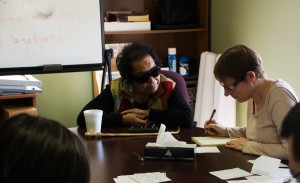
Hewankorn talks in a way that is plainspoken but playful. She demonstrates how to make one of Kootenai’s more distinct sounds, a slurred L. The tip of the tongue is pressed to the roof of the mouth, directly behind the teeth, and air is forced around it. The language may be musical, but she says: “You’ve got to learn to twist your tongue and gag and everything else.”
Hewankorn is working on transcribing Alec Lefthand’s story about unlikely lovers, Toad and Eagle.
She laughs through the transcription, she’s as much an audience member as a translator. “That’s a hell of a thing to say!” she exclaims when Toad is counseled to marry Eagle, a great hunter who never goes hungry.
Toad becomes infatuated with him. In one scene, Eagle returns home to Toad after a hunt. “Oh yeah…” says Hewankorn, listening to the recording. She translates: Toad sits down next to Eagle and puts her arm around him.
Lefthand’s voice speaks more Kootenai.
“Oh. My. God.”
Toad has wrapped her arms around Eagle’s waist.
“That’s one way of getting a guy, I guess.”
More Kootenai.
“Oh. My. God.”
That night, they lie down together and Toad never lets go.
When Hewankorn is listening, she rests her chin on her hand. She wears a gold ring, not bright gold, but not
tarnished either. Her late husband, Charlie Hewankorn, is spoken of often. To hear everyone tell it, Charlie was the expert speaker they looked up to, much the way they look up to Alice now.
 Finley says in recent years it feels like almost every death in the community is a fluent speaker. There are the people on the tapes: Mary Andrew, Alec Lefthand, Adeline Mathias. There are the other people that have worked on the transcriptions in the past: Charlie Hewankorn, Lucy Caye. Sarah Bufton is still alive, but had to give up the transcription work.
Finley says in recent years it feels like almost every death in the community is a fluent speaker. There are the people on the tapes: Mary Andrew, Alec Lefthand, Adeline Mathias. There are the other people that have worked on the transcriptions in the past: Charlie Hewankorn, Lucy Caye. Sarah Bufton is still alive, but had to give up the transcription work.
They’ve all left their mark on the language, but their era is coming to an end.
As Alice and Berney near the end of their workday, Toad and Eagle’s story takes a turn. Toad won’t let go of Eagle, so Eagle can’t hunt. They run out of food. Eagle has to hunt, but Toad insists on hanging on his back. Eagle flies under a branch and knocks off Toad.
“Broke up like glass,” Alice says.
But then Toad’s mother finds her broken body, puts the bones back together, brings her back to life. When Alice and Berney stop for the day, the Toads are plotting revenge.
BERNEY ONCE asked Catherine her opinion of somebody’s Kootenai rendering of, “The sun is up, the birds are singing.”
“They aren’t all singing!” Catherine told her. “Maybe white man bird does, but Kootenai’s birds, they sound happy, they’re chirping, they’re making all kinds of noise!”
“Every single elder speaker I know, they just want their language to be recognizable to them,” says Berney. “Sometimes they’ll shake their head and say, ‘Well, that’s their language. I guess I’ll have a whole other language.’”
The great fear for those who work in the trailer is that without fluent speakers, Kootenai will undergo a sea change, transforming from a native language that expresses native ideas to a native language that sees the world as the suyapi does. They all recognize high fluency is probably unattainable for future generations, which only strengthens their resolve to be precise and accurate.
While some might argue that the primacy of the Kootenai of elders past is an illusion, that languages are bound to change. Berney doesn’t agree.
“I know everyone says that languages change and they adapt, but the kind of change we’re talking about is not natural language change,” she said. “That’s over the course of a lot of time by actual first language learners, native speakers. Time and distance, languages eventually change. American English is quite different from British English. But it wasn’t a bunch of people who don’t know the language mispronouncing English.”
“You’ll be somebody then, if you learn your language.”
Even so, language is tied to life experience. The recordings are incredibly useful but limited in number.
Stiffarm jokes about many of the storytellers on the recordings being women. “I was telling Dorothy a couple of weeks ago, I’m like, ‘Hey, I’ll get fluent, or as fluent as I can off the recordings and classes and whatnot, but if you take me back 200 years, I’ll talk, and people would be looking at me, saying, Why are you talking like a woman?’”
The language trailer is rarely without laughter, but there is always an undercurrent of sadness. All the women mention getting lonely and calling Dorothy to talk Kootenai. Even Stiffarm wears a kind of wistfulness between his smiles.
It is hard not to hear every story as a metaphor for Kootenai itself; hard not to see each name jotted on one of Stiffarm’s maps as a Shibboleth of some magical, once-proud people. Language is a tool humans use to cross the threshold between the world inside themselves and the worlds beyond.
“You’ll be somebody then, if you learn your language,” Catherine says to the younger generations.
If the goal were simply to try and ensure continued fluent use of Kootenai, the work might only be sad and quixotic. But Catherine’s emphasis is on “your,” not on “language.” The novel aspect of the work she, her sister, Alice Hewankorn, Stiffarm, Finley and Berney are doing is that they are resolved to settle for nothing less than the language as they know it should be — which makes the work noble.
They will see Toad reconstituted, not a monster’s carcass with a suyapi name. Perhaps no one will ever again speak Kootenai at the level of the transcribers, but the Kootenai they do learn, to whatever level they learn it, will be Kootenai, real Kootenai, the Kootenai that animates the rivers, the hills, the valleys. A people.
- Preserving Kootenai comes down to waveforms. Daniel Stiffarm works to make Kootenai recordings from the 1970s clean and clear. Then, native speakers and linguist Dorothy Berney can transcribe them.
- Daniel Stiffarm isn’t fluent in Kootenai, but he probably hears the most out of anyone on the Flathead Indian Reservation because his work entails digitizing old recordings of Kootenai speakers. As a hunter, he is personally connected to the language through traditional place names on the reservation.
- Alice Hewankorn stands outside her old schoolhouse in Elmo. Unlike the Catholic boarding schools, Hewankorn’s teachers encouraged her to speak Kootenai in addition to English.
- Daniel Stiffarm consults a map atop Sullivan Hill. His map is covered with Kootenai place names scribbled next to their English counterparts.
- Alice Hewankorn pauses over a word during a transcription session. Kootenai doesn’t translate directly to English, so Hewankorn must be creative in trying to capture the essence of the language in English.
- Alice Hewankorn and linguist Dorothy Berney puzzle over Berney’s collected “language scraps,” the notes she makes whenever she hears a new Kootenai word or phrase. Berney speaks Kootenai and continues to learn the subtleties of the language through the transcription process.
- Louise Andrew, left, and Catherine Andrew, right, laugh while sharing a story about their youth. As children the sisters studied at the Ursuline Academy of St. Ignatius. They didn’t know very much English when they started. One day, Catherine’s teacher asked her to go check the time on the big clock in the hallway. Petrified, Catherine went to look. She came back and said the only number that she knew, “44.”
 Native News Project 2014 | School of Journalism – University of Montana Native News Project 2014
Native News Project 2014 | School of Journalism – University of Montana Native News Project 2014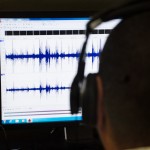
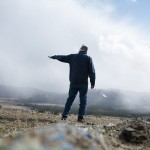
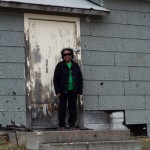
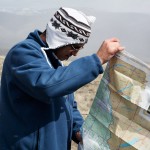

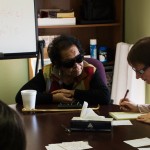
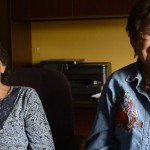


Recent Comments